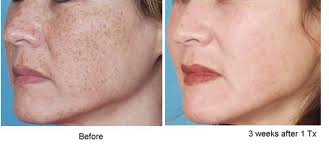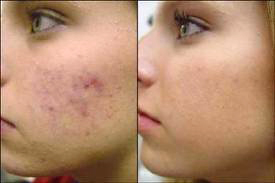
IPL Photofacial
Tired of using tons of makeup to cover up unwanted age spots, sun damage, freckles and acne scars? Or wasting money on creams and serums that promise to lighten brown spots? If you are looking to start getting results and stop wasting time and money, you are in the right place.
What is a Photofacial and How Does it Work?
Photofacial (also known as Intense Pulsed Light Therapy) treatments are the gold standard for improving skin tone and surface imperfections such as:
- Sun spots (face, chest, back and shoulders)
- Freckles
- Blood vessels and rosacea
- Post-acne discoloration (post-inflammatory hyperpigmentation)


A Photofacial uses an Intense Pulsed Light technology (IPL) which is a high-powered, broad spectrum light through a handheld applicator. This light is then transmitted into the skin, targeting any areas or spots that are darker than your normal skin tone, ie brown and red discoloration.
These targets absorb the light which is then converted to heat. The heat essentially lifts brown spots to the surface causing them to crust and flake off revealing a more even complexion. Blood vessels coagulate and are reabsorbed by the body, causing them to fade from view. The result is more youthful looking skin that is clear in tone.
With a series of sessions, you may see an improvement in fine lines and wrinkles.
Photofacials are Quick and Easy
A full face Photofacial takes approximately 20 minutes. First, a layer of cold gel is applied to the area being treated. Then, a cold handpiece, about the size of a nickel, is placed directly on the skin and the technician pulses the machine to deliver a flash or light and heat. This pattern is continued till the whole case has been covered. Typically two passes are performed.
Who is NOT a candidate for Photofacial?
Because Photofacials target melanin (color) in the skin, it is not recommended to treat tan skin or a Fitzpatrick skin type five or six, which means you have medium brown to black skin. Photofacials also cannot be performed on sunburned skin or on skin conditions such as melasma that are triggered by heat.
Combine your Photofacial with a Chemical Peel
Photofacials work best when the skin is newly exfoliated of dead skin cell build-up because the results are dependent on the light being able to deeply penetrate the layers of the skin. A chemical peel, such as a Jessner’s or VI Peel, can be done 1-2 weeks before your Photofacial treatment to enhance results.
BOOK A COMPLIMENTARY CONSULTATION
COMMONLY ASKED QUESTIONS
The procedure is fast and non-invasive. Individual experiences do vary, but some patients experience minimal to no discomfort during the procedure. The sensation is sometimes compared to the snapping feeling of a rubber band or a warm sensation.
One can continue with normal activities immediately following the procedure and wear makeup. The sun spots will appear darker for 4-10 days. During that time, one can go about normal like with makeup on.
While the name might imply otherwise, a Photofacial can be done on the face (including partial face), chest, shoulders and back.
Depending on the amount and severity of the sun damage, 3-9 treatments will be recommended. During a complimentary consultation, we will determine the appropriate amount of treatments for your specific situation.
The Photofacial IPL technology is FDA-approved and guaranteed to penetrate the skin safely. During the procedure, patients wear safety glasses or goggles to protect their eyes.
Photofacial side effects are very rare, but some patients experience mild redness or swelling. These effects generally fade within hours after the procedure. Veins may appear slightly redder and brown spots may appear slightly darker in the week following the procedure; this is normal. Patients are allowed to use makeup immediately post-procedure.
Yes, light therapy is safe to have done while pregnant or breastfeeding. Some laser treatments are not safe as the machine emits radiation, however, light therapy does not emit any radiation and is thereby completely safe. Since pregnant women cannot use skin lighteners, IPL is actually the best choice for lightening hyperpigmentation!
